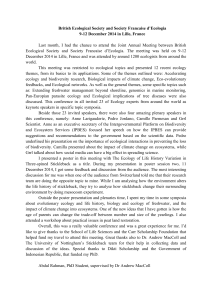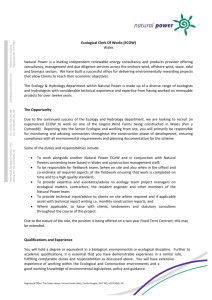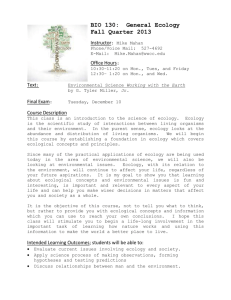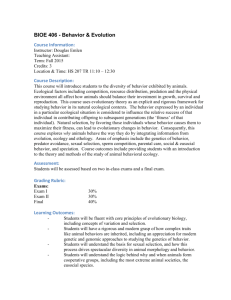Laney_IRBProposal
advertisement
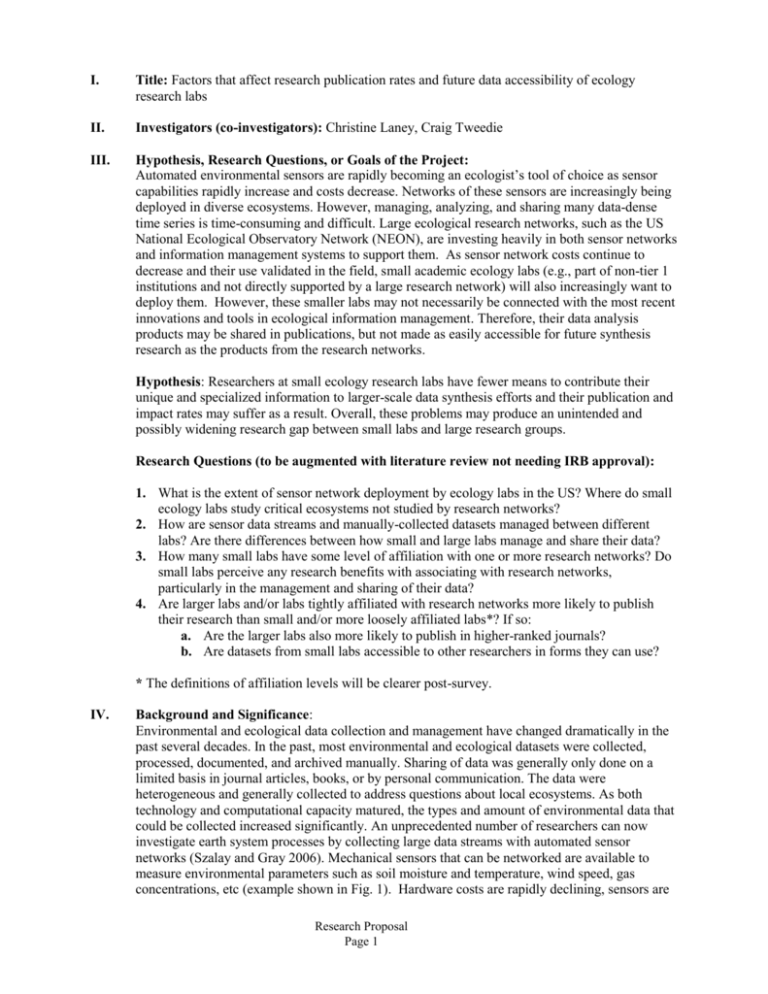
I. Title: Factors that affect research publication rates and future data accessibility of ecology research labs II. Investigators (co-investigators): Christine Laney, Craig Tweedie III. Hypothesis, Research Questions, or Goals of the Project: Automated environmental sensors are rapidly becoming an ecologist’s tool of choice as sensor capabilities rapidly increase and costs decrease. Networks of these sensors are increasingly being deployed in diverse ecosystems. However, managing, analyzing, and sharing many data-dense time series is time-consuming and difficult. Large ecological research networks, such as the US National Ecological Observatory Network (NEON), are investing heavily in both sensor networks and information management systems to support them. As sensor network costs continue to decrease and their use validated in the field, small academic ecology labs (e.g., part of non-tier 1 institutions and not directly supported by a large research network) will also increasingly want to deploy them. However, these smaller labs may not necessarily be connected with the most recent innovations and tools in ecological information management. Therefore, their data analysis products may be shared in publications, but not made as easily accessible for future synthesis research as the products from the research networks. Hypothesis: Researchers at small ecology research labs have fewer means to contribute their unique and specialized information to larger-scale data synthesis efforts and their publication and impact rates may suffer as a result. Overall, these problems may produce an unintended and possibly widening research gap between small labs and large research groups. Research Questions (to be augmented with literature review not needing IRB approval): 1. What is the extent of sensor network deployment by ecology labs in the US? Where do small ecology labs study critical ecosystems not studied by research networks? 2. How are sensor data streams and manually-collected datasets managed between different labs? Are there differences between how small and large labs manage and share their data? 3. How many small labs have some level of affiliation with one or more research networks? Do small labs perceive any research benefits with associating with research networks, particularly in the management and sharing of their data? 4. Are larger labs and/or labs tightly affiliated with research networks more likely to publish their research than small and/or more loosely affiliated labs*? If so: a. Are the larger labs also more likely to publish in higher-ranked journals? b. Are datasets from small labs accessible to other researchers in forms they can use? * The definitions of affiliation levels will be clearer post-survey. IV. Background and Significance: Environmental and ecological data collection and management have changed dramatically in the past several decades. In the past, most environmental and ecological datasets were collected, processed, documented, and archived manually. Sharing of data was generally only done on a limited basis in journal articles, books, or by personal communication. The data were heterogeneous and generally collected to address questions about local ecosystems. As both technology and computational capacity matured, the types and amount of environmental data that could be collected increased significantly. An unprecedented number of researchers can now investigate earth system processes by collecting large data streams with automated sensor networks (Szalay and Gray 2006). Mechanical sensors that can be networked are available to measure environmental parameters such as soil moisture and temperature, wind speed, gas concentrations, etc (example shown in Fig. 1). Hardware costs are rapidly declining, sensors are Research Proposal Page 1 becoming smaller and more reliable, and software embedded in the sensors are allowing them to communicate among themselves and to larger computers (Rundel et al. 2009). Continuously recording sensor networks can allow researchers to better address complex, critical questions about ecosystem and earth system processes (Benson et al 2010). Ecological sensor networks are being built at both individual research stations supported by small labs and at larger scales by research networks (e.g., the Long-Term Ecological Research Network [LTER] and the National Ecological Observatory Network [NEON]) (Porter et al. 2005, Rundel et al. 2009). These often supplement field work that can’t be done solely with sensors (e.g., animal population studies). Figure 1. The Jornada site, managed by the Systems Ecology Lab at UTEP. Clockwise from top left: 1) eddy covariance tower, 2) tram line for robotic cart that performs spectral measurements, with a sensor node (one of eight in an array) positioned over it, 3) a raingauge, 4) a diagram of the wireless networking system, 5) a sensor node that measures reflected solar radiation and photosynthetically active radiation, soil moisture, and soil temperature. As large ecological research networks mature and expand, it is important to minimize, or even decrease, gaps in technology and data sharing between large networks and small labs. Small labs are crucial for filling in data from spatial gaps between large network projects (Brunt and Michener 2009) and for revealing the critical details of interactions between the atmosphere, land, and biotia (Lehning et al. 2009). In addition, small labs can organize and begin new research quickly relative to larger cross-institutional collaborative and networks. By scaling research out with cheap sensors, rather than up with large infrastructures, small labs may quickly leapfrog technology and/or come up with novel solutions to new problems more rapidly (Szalay and Gray 2009). In a university setting, face-to-face collaborations between environmental scientists, computer scientists, and information scientists may be a simple matter of coordinating weekly meetings. In addition, small labs may be able to more rapidly mobilize people on the ground to do ground-truthing, with an array of students and possibly volunteer citizen scientists (with exceptions to large networks that are specifically targeting citizen science, like the US National Phenology Network). Research Proposal Page 2 As the number of data collection methods increase, the complexity of managing and sharing multiple datasets and data streams also increases. A common goal is to integrate many datasets in the hope of solving urgent questions about rapid changes to the environment (Dozier and Gail 2009). Ecology as a science needs to make significant inroads on developing tools to help researchers with these complex tasks. The newly developing field of ecological informatics (or ecoinformatics), along with associated software applications, is arising from these needs. Ecoinformatics is interdisciplinary research between ecologists, computer scientists, software engineers, and statisticians and/or mathematicians. Ecoinformatics tools include databases, common vocabularies (ontologies), common documentation (metadata) standards, and programming to support data discovery (Michener et al. 2005, Michener 2006, Madin et al. 2007, Madin et al. 2008). Environmental applications use scientific information not only to address local or immediate questions, but to model future environmental scenarios (Dozier and Gail 2009), guide the formation of new hypotheses , and identify what new data need to be collected (Muggleton 2006). Thus, the advancement of science, informatics, and application-building is iterative, as each informs the other. Most of the advancement of ecoinformatics and funding to support new information management systems has been through large research institutions or networks, often with little participation from smaller labs, especially rural and minority serving institutions (Atkins et al, 2003, Rundel et al. 2009, Jones & Gries 2010). Few researchers from small labs have formal links to one or more of these networks; those that do appear to have improved access to research locations, funding, and systems for information management, analysis, and sharing. There appears to be little coordinated effort to help small labs that are unaffiliated with networks manage their data in ways that meet their own local information management and analysis needs and also allow easy sharing of data with larger networks (Kennedy et al. 2008). Small labs may have access to hardware (computers, external hard drives, servers), but not the connections to dynamic innovations in ecological information management, including evolving ontologies and new software (Kennedy et al. 2008). They may also not be aware of best practices, which evolve over time (Jones and Gries 2010; Michener et al. 2007). Therefore, data sets from small labs, which often describe unique ecosystems in geographic locations remote from national research network sites, may be lost to large and important data synthesis efforts. If data from small lab sensor networks are to be better integrated with other data across the US, it is important to understand more about how small labs set up sensor networks and manage the data streams. It is also important to better quantify and understand the linkages between small labs and large networks, and whether those links do and/or are perceived to contribute to better collection, management, and sharing of research products (datasets and papers). If small ecology labs are found to be lagging in technology deployment, data management, and/or publication rates, is it because small labs lack training, funding, and/or personnel, or is it for reasons beyond a small lab’s control (e.g., because research networks exclude participation either intentionally or unintentionally)? The survey described in this proposal will be a broad attempt to understand these patterns, and will enable the Systems Ecology Lab and partners within Cyber-ShARE to better target new Cyberinfrastructure efforts to meet the needs of small labs. References Atkins, D. E. et al. Revolutionizing Science and Engineering Through Cyberinfrastructure: Report of the National Science Foundation Blue-Ribbon Advisory Panel on Cyberinfrastructure. 84 (2003). Benson, B. J., et al. Perspectives on next-generation technology for environmental sensor networks. Front Ecol Environ 8, 193-200 (2010). Research Proposal Page 3 Brunt, J. W. & Michener, W. K. The Resource Discovery Initiative for Field Stations: Enhancing Data Management at North American Biological Field Stations. Bioscience 59, 482-487 (2009). Dozier, J. & Gail, W. B. in The Fourth Paradigm: Data-Intensive Scientific Discovery (eds Hey, T. et al.) (Microsoft Research, Redmond, WA, 2009). Jones, M. B. & Gries, C. Advances in environmental information management. Ecol Inform 5, 12 (2010). Kennedy, A. M., et al. Converting data to information: Coupling lab-level database functionality with primary LTER data archiving systems. (2008). Lehning, M. et al. in The Fourth Paradigm: Data-Intensive Scientific Discovery (eds Hey, T., Tansley, S. & Tolle, K.) (Microsoft Research, Redmond, WA, 2009). Madin, J. S., Bowers, S., Schildhauer, M. P. & Jones, M. B. Advancing ecological research with ontologies. Trends in Ecology & Evolution 23, 159-168 (2008). Madin, J. et al. An ontology for describing and synthesizing ecological observation data. Ecological Informatics 2, 279-296 (2007). Michener, W. et al. Data integration and workflow solutions for ecology. Data Integration in the Life Sciences, Proceedings 3615, 321-324 (2005). Michener, W. K. Meta-information concepts for ecological data management. Ecological Informatics 1, 3-7 (2006). Michener, W. et al. A knowledge environment for the biodiversity and ecological sciences. J Intell Inf Sys 29, 111-126 (2007). Muggleton, S. H. 2020 Computing: Exceeding Human Limits. Nature 440, 409-410 (2006). Porter, J. et al. Wireless sensor networks for ecology. Bioscience 55, 561-572 (2005). Rundel, P. W., Graham, E. A., Allen, M. F., Fisher, J. C. & Harmon, T. C. Environmental sensor networks in ecological research. New Phytol. 182, 589-607 (2009). Szalay, A. & Gray, J. 2020 Computing: Science in an Exponential World. Nature 440, 413-414 (2006). V. VI. Research Method, Design, and Proposed Statistical Analysis: This study has two main components. The first component, which is relevant to this IRB proposal, is a voluntary survey of ecologists and environmental scientists spanning graduate students to lab directors. The survey will be available online through a tool similar to Survey Monkey (to be determined). Self-identification will be completely voluntary and will not be used in any publication. Data will be grouped by institution tier ranking (identified from http://www.usnewsuniversitydirectory.com/undergraduate-colleges/nationaluniversities.aspx), lab funding, and participation with large ecological research networks. The second part of this study is a literature review of the top 15 journals in ecology to clarify questions about equity of publishing, and is thus not subject to IRB approval. See survey attached at the end of this document. Human Subject Interactions A. Sources of potential participants, derived materials, or data. The survey will be offered to approximately 1000 adult ecologists affiliated with US institutions and not from other countries. No questions will be asked regarding sex, ethnic background, or state of health. The survey will be handed out in English only. B. Procedures for the recruitment of the participants. Recruitment will occur via email (addresses obtained from meeting booklets and through networking) and face-to-face interaction at national meetings. Volunteers will be directed to the online survey. No interviews will take place. All follow up communications will be over email. The survey will be available via a web link. Research Proposal Page 4 C. Procedure for obtaining informed consent. The top of the survey will state that by filling out the questionnaire, participants agree that they are 18 or older and voluntarily consent to the data being published in a way that protects personal identity. D. Research Protocol. Participants will go to the survey online link and fill out the survey at their discretion and convenience. The responses should take less than 20 minutes. E. Protecting the privacy and confidentiality of participants: Participation in the survey is completely voluntary, and no personal information will be disclosed publically. F. Confidentiality of the research data. An online survey tool will be selected based on security of online data with the expectation that IP addresses will not be collected. The survey data will be downloaded into a password protected database on a server or laptop. G. Research resources. This research will use servers and websites established and maintained by the Systems Ecology Lab at UTEP. The data analysis will be done by the investigators. If necessary, another student may be involved in the project to help with data organization and analysis. VII. Potential risks. The primary risk is losing confidentiality of participants’ responses. The consequences are minimal socially or legally, since little personal information is requested. The data collectively (location, publication rate, funding) could be used collectively to try to infer a respondent’s name or lab group, but the risk is minimal. VIII. Potential benefits: There are no direct benefits to the participants. On the societal level, analysis of the data will lead to better understanding of the connections between research network participation, sensor network data management, and impact of research results. IX. Specific sites or agencies involved in the research project besides The University of Texas at El Paso. NA X. Review by another IRB: NA Research Proposal Page 5 Survey on Ecoinformatics adoption and research networking I. Information about your lab 1. What institution is your lab currently at? ____________________ 2. What year was your lab formed at your current institution? _______ 3. Please choose the primary research focus of your lab a. Biogeochemistry b. Landscape/ecosystem ecology c. Community/population ecology d. Freshwater ecology e. Oceanography f. Ecological informatics/cyberinfrastructure g. Urban Ecosystems h. Other: ____________________ 2. Please choose the secondary research focus of your lab a. Biogeochemistry b. Landscape/ecosystem ecology c. Community/population ecology d. Freshwater ecology e. Oceanography f. Ecological informatics/cyberinfrastructure g. Urban ecosystems i. Other: ____________________ 3. How many researchers are in your lab or work environment? a. PhD level researchers (including postdocs): ___ b. PhD students: _____ c. Master's students: _____ d. Undergraduate students: _____ e. Technicians: _____ f. Other: ______ (e.g. visiting researchers, volunteers etc – please specify) 4. What is your lab's approximate annual grant expenditure? _____________ 5. On the following map, please select the approximate coordinates of your current study area (only the midpoint and the total area will be shared in presentations and publications, not the boundary coordinates). [NOTE: This will be either a digital map, or 4 boxes to collect bounding points for the study area.] 6. On the following map, please select the approximate coordinates of your ideal study area, given expanded sensor network capabilities.[NOTE: This will be either a digital map, or 4 boxes to collect bounding points for the study area.] II. Data Collection, Present and Future 1. Approximately how much raw data does your lab collect annually? a. < 1 GB b. 1-10 GB Research Proposal Page 6 c. 10-100 GB d. >100 GB 2. How many sensor platforms does your lab use? _____ 3. What type of and how many functional electronic environmental sensors does your lab have in the field, and how many sensors would you ideally like to have? Sensor Type # the lab has currently # the lab would ideally have Basic weather sensors (rain gauges, thermometers, anemometers) Soil sensors (e.g., temperature, moisture, conductivity) Water sensors (e.g., temperature, salinity, conductivity, flow rate, etc.) Spectral sensors (e.g., PAR, solar radiation, APAR, etc.) Gas analyzers (e.g., CO2, CH4) Cameras (e.g., web cameras, phenocams) Sound sensors Animal tracking devices Other: _______________________ 4. What type of and how many functional electronic environmental sensor platforms does your lab have in the field, and how many platforms would you ideally like to have? Sensor Platform # the lab has currently # the lab would ideally have Unmanned aerial vehicle (UAV) Unmanned land vehicle Eddy covariance tower Short towers or tripods Robotic cart on tram line Buoy(s) situated in marine or aquatic environments Directly on the ecosystem surface (soil, rock, water, etc.) Animals (birds, rodents, etc.) 5. Estimate the approximate replacement cost of your current sensor network(s) (check one) ___ $0 (don’t have a sensor network) Research Proposal Page 7 ___ <$10,000 ___ $10,000-$100,000 ___ $100,000-$1 million ___ > $1 million 6. Estimate the approximate cost of your ideal sensor arry (check one) ___ $0 (don’t want to install a sensor array) ___ <$10,000 ___ $10,000-$100,000 ___ $100,000-$1 million ___ > $1 million 7. Which of the following do you think may limit your capacity to expand sensor array(s) needed to meet your research goals? Check all that apply (even if you are not interesting in installing new sensors, please check what you perceive limitations to doing so might be): ___ There are no limitations ___ Limited access to study areas of interest ___ Limited access to funding sources for hardware, software, and/or personnel ___ Limited understanding of cyberinfrastructure and information management solutions ___ Lack of necessary hardware (e.g. computers, servers) for data storage and/or computing ___ Limited access to necessary proprietary software ___ Difficulties in using open-source or free software ___ Limited training to collect and/or manage large data streams ___ Not enough programmers and/or information managers to work with ___ Poor institutional commitment and/or too many administrative limitations ___ Other: ___________________________ III. Networking 1. Do you collaborate (e.g., do research, submit publications) regularly with colleagues that are associated with an ecological research network? Yes/No 2. Are you a member of any ecological research network? Yes/No 3. If not, would you like to be? Yes/No 4. Whether you are affiliated with a research network or not, what factors do you think might act as barriers to a small lab that would like to affiliate itself with a research network? For each factor, select one of the answers to the right. Factor Is not a barrier Compliance rules of your institution Compliance rules of the network Field site overlaps with your current or desired field site There is no network that does similar research The data policy of the network is too lenient Research Proposal Page 8 Is a slight barrier Is a strong barrier Don’t know 5. What is your current level of involvement with the following ecological research networks? Network Not a member Am a member without financial or other support Am a member with < the equivalent of $10000/year in support Am a member with > the equivalent of $10000/year in support NEON LTER OBFS OOS Ameriflux FLUXNET SpecNet LTREB Other:___________ 6. As a current or potential member of a large research network, do you think that such membership offers the following opportunities? 1 (agree)-5 (disagree). Opportunity 1 (strongly agree) 2 (agree) Collaboration Access to more collaborators Access to more information about my area of interest More interesting dialog pertaining to my area of interest Better access to more datasets related to my own line(s) of research Better access to potential co-authors Better opportunities to publish in high-tier journals Research Proposal Page 9 3 (neutral; no clear opportunity) 4 (disagree) 5 (strongly disagree) Work with people on synthesis papers? Technology Better access to hardware, such as computers and sensors Better access to software for data analysis Better access to software for data storage Better access to software for data documentation Better cyberinfrastructure systems to help manage all components of research Personnel Better access to people who understand the needs of managing, analyzing, and sharing ecological data More opportunities for graduate research Easier to document data Easier to share data with the global community of ecologists. IV. Data Availability 1. Do you use online data repositories to find data for your studies? Yes/No 2. Do you have a lab website? Yes/No If so, please feel free to share your URL:______________ (URL will not be shared but may be visited for further research) 3. Do you post any data on your lab website? Yes/No 4. If so, what percentage? _____ 5. Do you submit your data to an online data repository? Yes/No 6. If so, check which ones in the appropriate column marked with the approximate number of published datasets: Research Proposal Page 10 Network No data <5 datasets/year 5-20 datasets/year >20 datasets/year Research networks (e.g., Ameriflux, SpecNet, LTER, etc.) Journal databases (e.g., the ESA data repository) Data centers (e.g., KNB repository, DataOne, NBII, etc.) University databases Lab archives 7. What format(s) does your lab use for data (check all that apply): ___ ASCII (e.g., comma- or tab-separated values) ___ Word processing documents (e.g., Microsoft Word, WordPerfect, OpenOffice) ___ Spreadsheet software (e.g., Microsoft Excel, OpenOffice) ___ Relational databases (e.g., MySQL, PostgreSQL, geodatabase) ___ JSON ___ NetCDF, RDF, etc. ___ Spatial file formats (e.g., shapefiles, raster, vector) ___ Other (list here): _______________________ 8. In what format(s) do your metadata, or contextual information about your data, exist? (check all that apply): ___ Hand-written notes ___ ASCII (e.g., plain text [.txt] or rich text format [.rtf] ___ Word processing documents (e.g., Microsoft Word, WordPerfect, OpenOffice) ___ Spreadsheet software (e.g., Microsoft Excel, OpenOffice) ___ Relational databases (e.g., MySQL, PostgreSQL) ___ Ecological Metadata Language [EML] ___ Federal Geographic Data Committee [FGDC] standards ___ Sensor Metadata Language [SensorML] ___ Other (list here): _______________________ 9. Do you use ontologies or work flows as a way to standardize your data documentation? Yes/No 10. If you use ontologies, please list what you use: _____________________________________ 11. Do you use work flows to automate your data processing? Yes/No 12. If so, what software do you use? ______________________________ Research Proposal Page 11 V. Publication types, rates, and quality 1. How many publications from 2007-2011 has your lab (at your current institutional address) had accepted into a peer-reviewed journal? ____? 2. How long does it generally take for a paper in your lab to be written (from the time experimental results are available) and submitted to a journal? (choose one): ___ 0-6 months ___ 6-12 months ___ 12-18 months ___18-24 months ___ more than 2 years 3. How long does it generally take a paper to be published after submission to a journal (including review time) (choose one)? ___ 0-6 months ___ 6-12 months ___ 12-18 months ___18-24 months ___ more than 2 years 4. What journals have you published in since 2005? Number of Papers Journal* 0 American Naturalist Annual Review of Ecology, Evolution, and Systematics Conservation Biology Ecological Applications Ecological Informatics Ecological Monographs Ecology Ecology Letters Evolution Frontiers in Ecology and the Environment Functional Ecology Global Change Biology Global Ecology and Biogeography: A Journal of Macroecology Journal of Applied Ecology Journal of Ecology Molecular Ecology Oecologia Oikos Perspectives in Plant Ecology, Evolution and Systematics Research Proposal Page 12 1-5 >5 Proceedings of the Royal Society B - Biological Sciences Trends in Ecology and Evolution Urban Ecosystems Wildlife Monographs OTHER:____________________ * Top journals in ecology, including those with the highest 5-year impact factors as listed by Thompson-Reuters at http://admin-apps.webofknowledge.com/JCR/JCR, with modifications to remove journals not considered relevant for this study (e.g., Heredity) and to add common ecology journals that are listed with lower 5-year impact ratings (e.g., Oecologia). 5. Do you think you can publish higher-impact papers if you (check all that apply): ___ collect more data ___ publish more data in an online archive ___ install more sensors or sensor arrays ___ become an affiliate of one or more research networks ___ have more ready access to data; ___ have access to more scientific expertise Research Proposal Page 13
